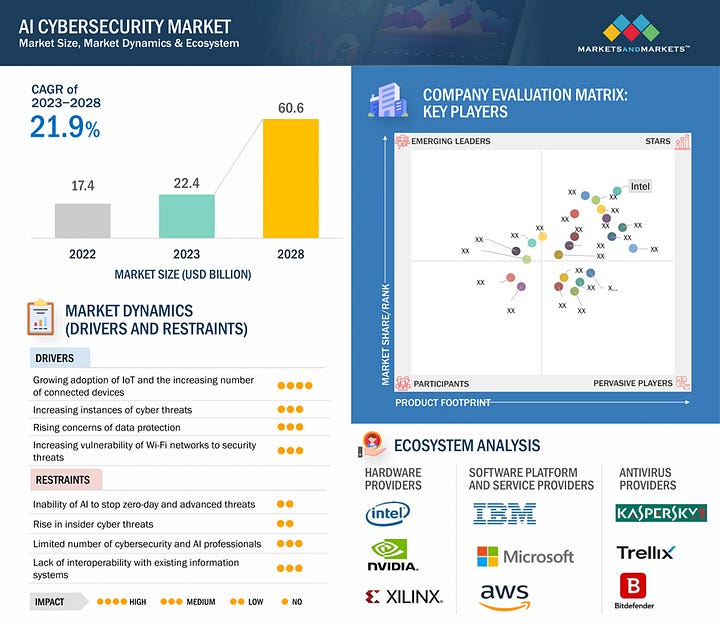AI-Powered Cybersecurity: Fueling Growth in North America's Market
Artificial Intelligence in Cybersecurity Market size was valued at USD 22.4 billion in 2023 and is expected to grow at a CAGR of 21.9% from 2023 to 2028. The revenue forecast for 2028 is projected to reach $60.6 billion. The base year for estimation is 2022, and the historical data spans from 2023 to 2028
AI-powered cybersecurity represents a significant advancement in defending against cyber threats by leveraging artificial intelligence to monitor, analyze, detect, and respond in real time. This technology marks a crucial evolution in cybersecurity capabilities, offering several key benefits and functionalities.

Real-Time Threat Monitoring
AI algorithms continuously monitor network traffic, system logs, and user behaviors to identify anomalous activities that may indicate a potential cyber threat. Unlike traditional methods that rely on predefined rules, AI can detect subtle deviations from normal patterns, enhancing the ability to identify emerging threats promptly.
Advanced Threat Analysis
AI excels in analyzing vast amounts of data at high speed, enabling it to identify complex attack patterns and correlations across different data sources. By integrating machine learning techniques, AI-powered systems can learn from historical data and adapt to evolving threats, improving accuracy in threat detection and reducing false positives.
Report copy — https://www.marketsandmarkets.com/requestsampleNew.asp?id=220634996
Rapid Detection and Response
One of the primary advantages of AI-powered cybersecurity is its ability to detect threats in real time. Upon detecting suspicious activities or anomalies, AI systems can trigger immediate responses, such as isolating compromised systems, blocking malicious traffic, or alerting cybersecurity teams for further investigation. This swift response minimizes the impact of cyberattacks and reduces the window of exposure for potential damage.
Key Market Players
The AI in Cybersecurity market vendors have implemented various types of organic and inorganic growth strategies, such as partnerships and agreements, new product launches, product upgrades, business expansions, and mergers and acquisitions to strengthen their offerings in the market. The major vendors in the global market for AI in Cybersecurity include NVIDIA (US), Intel (US), Xilinx Inc. (US), Samsung Electronics Co., Ltd (South Korea), Micron Technology, Inc. (US), IBM Corporation (US), Amazon Web Services, Inc. (US), Microsoft (US), Palo Alto Networks Inc. (US), Trellix (US), CrowdStrike (US), Norton LifeLock (US), Cylance Inc. (US), ThreatMetrix Inc. (US), Securonix Inc. (US)
Automation of Routine Tasks
AI automates routine cybersecurity tasks such as log analysis, threat prioritization, and incident response workflows. This automation allows cybersecurity professionals to focus on more strategic initiatives and complex threat investigations, enhancing overall efficiency and productivity within security operations.
Scalability and Adaptability
AI-powered cybersecurity solutions are highly scalable, capable of handling large volumes of data and expanding to protect diverse IT environments. Whether deployed in small businesses or large enterprises, AI systems can adapt to different network architectures and security protocols, providing tailored protection against a wide range of cyber threats.
Predictive Capabilities
By analyzing historical data and identifying trends, AI can predict potential cyber threats before they manifest into actual attacks. This predictive capability allows organizations to proactively strengthen their defenses and implement preemptive measures to mitigate future risks.
Challenges and Considerations
Despite its advantages, AI-powered cybersecurity also presents challenges such as the need for robust data privacy measures, ensuring transparency in AI decision-making processes, and addressing potential biases in AI algorithms. Additionally, ongoing training and updates are essential to keep AI models effective against emerging threats and evasion techniques employed by cybercriminals.
In conclusion, AI-powered cybersecurity represents a transformative approach to defending against cyber threats in real time, offering enhanced detection capabilities, rapid response times, and scalability across diverse IT environments. As organizations increasingly adopt AI-driven solutions, they are better positioned to protect sensitive data, mitigate risks, and maintain resilience in the face of evolving cyber threats.

Comments
Post a Comment